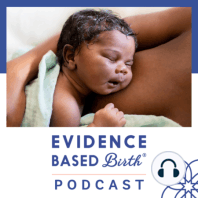17 min listen
EBB 113 - The Evidence on VBAC
ratings:
Length:
44 minutes
Released:
Jan 29, 2020
Format:
Podcast episode
Description
In this episode, I am excited to share the evidence on vaginal birth after Cesarean, or VBAC. We have received many requests at Evidence Based Birth to cover this topic, so I want to share with you the information on VBAC that I present in a class we teach in the EBB Higher Ed program. In this podcast, I define some common terms related to VBAC and talk about the history of the procedure. By the end, you will have the facts on the prevalence and risk factors for uterine rupture, and you’ll understand some of the maternal, fetal, and newborn risks of VBAC, elective repeat Cesarean, and Cesarean birth after Cesarean. For more information and news about Evidence Based Birth®, visit www.ebbirth.com. Find us on Facebook, Instagram, and Pinterest. Ready to get involved? Check out our Professional membership (including scholarship options) and our Instructor program. Find an EBB Instructor here, and click here to learn more about the Evidence Based Birth® Childbirth Class. RESOURCES: American College of Obstetricians and Gynecologists/ Society for Maternal-Fetal Medicine (2018). Placenta accreta spectrum. Obstetric Care Consensus No. 7. Obstet Gynecol, 132, e259-275. Click here. Free full text! Bujold, E., Goyet, M., Marcoux, S., et al. (2010). The role of uterine closure in the risk of uterine rupture. Obstet Gynecol, 116(1), 43-50. Carlton Fagerberg, M. and Källén, K. (2019). Third trimester prediction of successful vaginal birth after one cesarean delivery - a Swedish model. Acts Obstet Gynecol Scand. (Epub ahead of print.] Click here. Grobman, W. A., Lai, Y., Landon, M. B., et al. (2007). Development of a nomogram for prediction of vaginal birth after cesarean delivery. Obstet Gynecol, 109, 806. Click here. VBAC calculator for use at first prenatal visit: https://mfmunetwork.bsc.gwu.edu/PublicBSC/MFMU/VGBirthCalc/vagbirth.html\ Guise, J.-M., Eden, K., Emeis, C., et al. (2010). Vaginal Birth After Cesarean: New Insights. Evidence Report/Technology Assessment No.191. (Prepared by the Oregon Health & Science University Evidence-based Practice Center under Contract No. 290-2007-10057-I). AHRQ Publication No. 10-E003. Rockville, MD: Agency for Healthcare Research and Quality. Click here. Free full text! Landon, M. B., Hauth, J. C., Leveno, K. J. et al. (2004). Maternal and Perinatal Outcomes Associated with a Trial of Labor after Prior Cesarean Delivery. N Engl J Med, 351, 258-2589. Click here. Free full text! Landon, M. B., Grobman, W. A. and Eunice Kennedy Shriver National Institute of Child Health and Human Development Maternal–Fetal Medicine Units Network (2016). What We Have Learned About Trial of Labor After Cesarean Delivery from the Maternal-Fetal Medicine Units Cesarean Registry. Seminars in perinatology, 40(5), 281–286. Click here. Free full text! Metz, T. D., Stoddard, G. J., Henry, E., et al. (2013). Simple, validated vaginal birth after cesarean delivery prediction model for use at the time of admission. Obstet Gynecol, 122, 571. Click here. Free full text! VBAC calculator for use at time of admission for birth: https://mfmunetwork.bsc.gwu.edu/PublicBSC/MFMU/VGBirthCalc/vagbrth2.html Sandall, J., Tribe, R. M., Avery, L., et al. (2018). Short-term and long-term effects of caesarean section on the health of women and children. Lancet, 392(10155), 1349-1357. Click here. Silver, R. M., Landon, M. B., Rouse, D. J., et al. (2006). Maternal morbidity associated with multiple repeat cesarean deliveries. Obstet Gynecol, 107(6), 1226-1232. Click here. Smith, G. C. S., Pell, J. P., Cameron, A. D., et al. (2002). Risk of Perinatal Death Associated With Labor After Previous Cesarean Delivery in Uncomplicated Term Pregnancies. JAMA, 287(20), 2684–2690. Click here. Free full text! Vlemminx, M. W., de Lau, H. and Oei, S. G. (2017). Tocogram characteristics of uterine rupture: a systematic review. Archives of gynecology and obstetrics, 295(1), 17–26. Click here. Free full text! Access the International Cesarean Awareness Network
Released:
Jan 29, 2020
Format:
Podcast episode
Titles in the series (100)
EBB 1: Intro to Evidence Based Birth®: Welcome to the Evidence Based Birth® podcast! In this first episode, Rebecca Dekker, PhD, RN, the founder of EBB, shares the story of how evidence based birth began. To learn more about her story, visit ebbirth.com/author To learn more about... by Evidence Based Birth®
